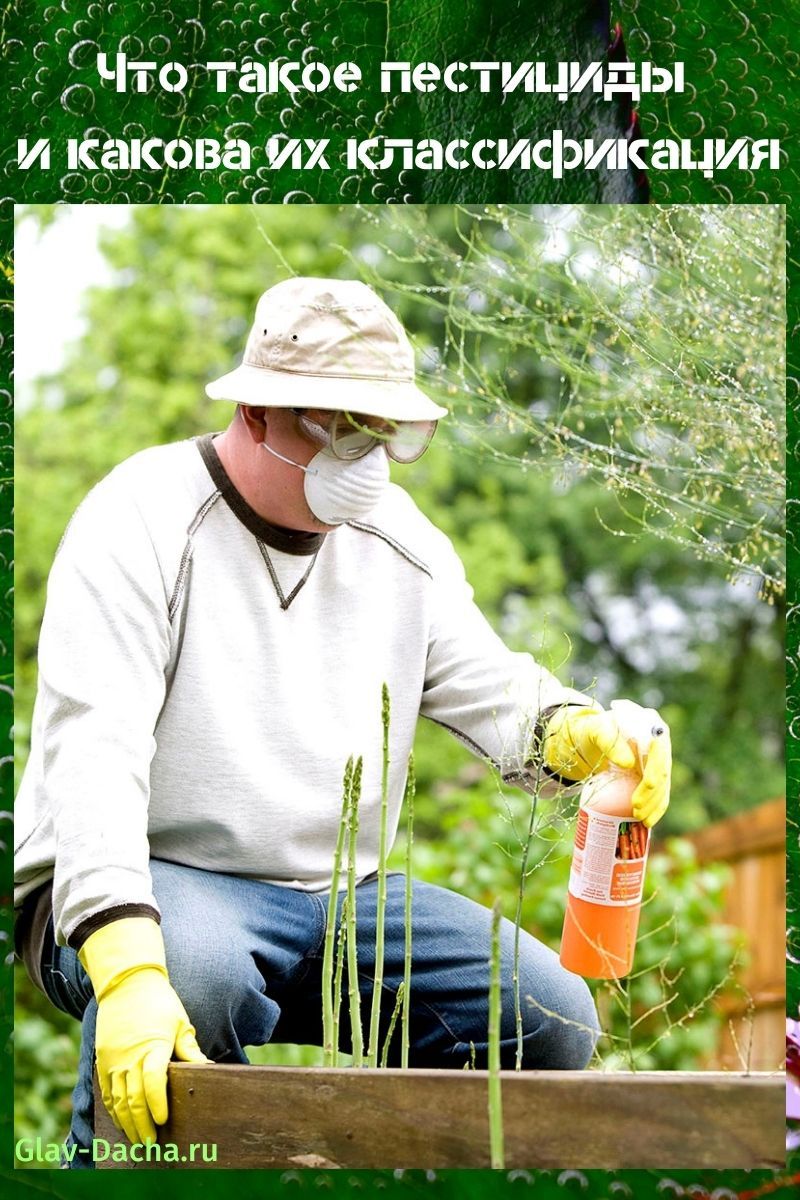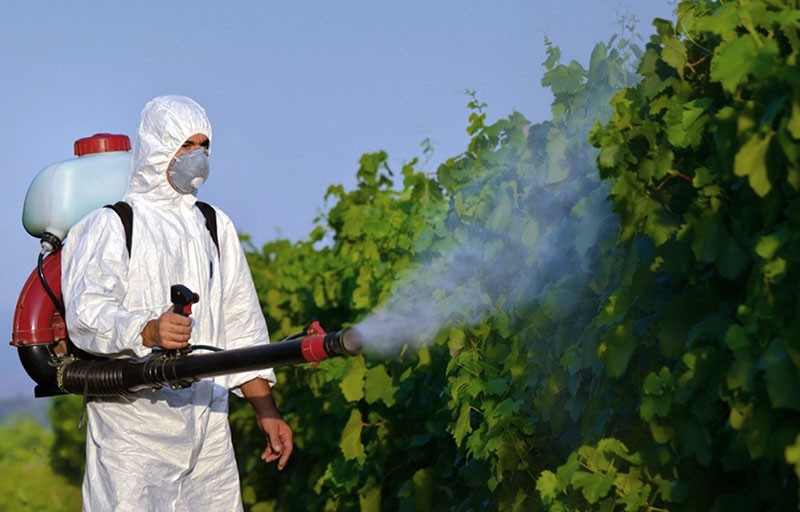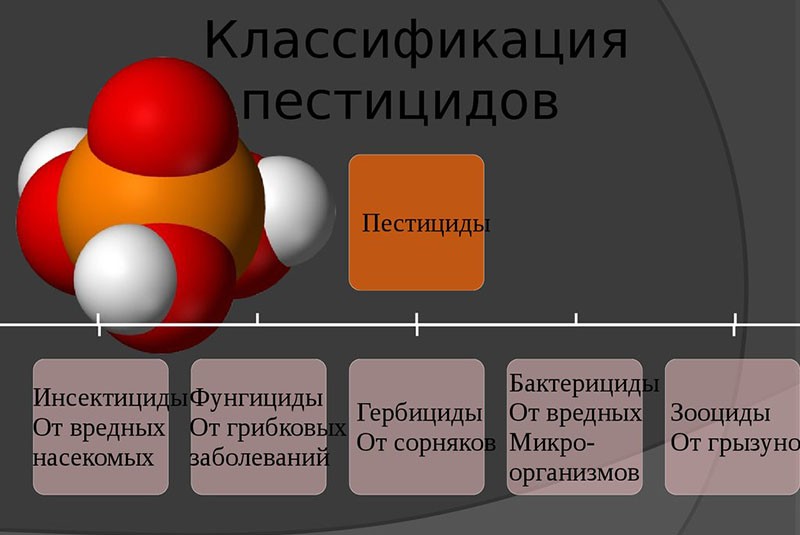What are pesticides and what is their classification
 Getting a generous harvest of vegetables, fruits and berries is impossible without effective protection of plants from diseases and insect pests. To grow a garden, fruit and berry or vegetable crop and get a really rich harvest, both on personal plots and on an industrial scale, you need to know what pesticides are and how to use them correctly.
Getting a generous harvest of vegetables, fruits and berries is impossible without effective protection of plants from diseases and insect pests. To grow a garden, fruit and berry or vegetable crop and get a really rich harvest, both on personal plots and on an industrial scale, you need to know what pesticides are and how to use them correctly.
What are pesticides - main features

Pesticides are used in private gardening and agriculture to effectively protect cultivated plants from various pests that impair their growth and reduce productivity.:
- insect pests;
- ticks;
- nematodes;
- pathogenic microorganisms;
- viruses;
- fungal spores;
- weeds;
- rodents.
Various types of pesticides for individual farms and agricultural fields contain safe compounds, since potent substances are dangerous not only for pests, but also for people and animals.
Despite the environmental friendliness and safety of modern pesticides, it must be taken into account that they are capable of penetrating the soil and groundwater, and their vapors get into the air. That is why the use of agricultural protection means is carried out in strict compliance with the instructions.
Pesticide classification
 The classification of pesticides is based on the peculiarities of their chemical composition, the group of suppressed pests, the specificity (nature) of the impact, the method of penetration and the level of toxicity. There are more than 1000 different pesticides on the market for agricultural protection products, which have significant differences and belong to different types.
The classification of pesticides is based on the peculiarities of their chemical composition, the group of suppressed pests, the specificity (nature) of the impact, the method of penetration and the level of toxicity. There are more than 1000 different pesticides on the market for agricultural protection products, which have significant differences and belong to different types.
Depending on the active substance, pesticides are divided into groups:
- Inorganic agents - this class includes compounds and derivatives of copper, sulfur, barium, fluorine and mercury, as well as borates and chlorates. Lime and sulfur are common "representatives" of the group.
- Preparations of fungal, bacterial and natural origin - this category includes phytoncides, antibacterial, antifungal agents, pyrethrins.
- Organic products are the most extensive class, characterized by maximum physiological activity against a wide range of pests.
Organic drugs include the following groups of pesticides - synthetic pyrethroids, carbamates, mineral oils, phenylpyrazoles, neonicotinoids. Also, the category of organic agents includes preparations from the category of organochlorine and organophosphorus compounds - preparations of phosphonic acids, thiophosphoric, benzoic, dithiophosphoric and phosphoric acids.
Classification depending on the purpose of use
 Depending on the chemical pesticides, the goals and areas of use of agricultural protection products differ.
Depending on the chemical pesticides, the goals and areas of use of agricultural protection products differ.
The most common types:
- avicides - preparations for scaring away or destroying birds eating crops;
- acaricides - to protect plants from ticks, disrupt their development and growth;
- algicides - for the destruction of algae in water bodies;
- anthelminths - designed to destroy parasitic worms;
- anti-resistants - the action of these funds is aimed at reducing the resistance (resistance) of pests to pesticide chemicals;
- antifidants - designed to protect crops from being eaten by animals and insects;
- arboricides - to destroy unwanted shrubs and trees;
- attractants - used to attract and lure pests into traps;
- aphicides - to kill aphids;
- bactericides - against bacteria that infect plants and are in the ground;
- viricides - against viral pathogens;
- herbicides - to destroy, stop the growth and development of weed crops;
- herbicide safeners - to protect plants during herbicide treatment;
- defoliants - to remove individual leaves of a plant;
- insecticides - to protect cultivated plants from a wide range of insect pests;
- molluscicides (or limacids) - against slugs and snails;
- nematicides - to control nematodes;
- repellents - the action is aimed at repelling insects;
- rodenticides - against mice, rats and other rodents;
- fungicides - for the destruction of fungal spores and oomycetes;
- chemosterilants - for sterilizing pests.
Synergistic substances are also on the list of pesticides. By themselves, they do not pose a toxic hazard to pests, but they increase the toxicity and effectiveness of pesticides.
Classification by the mechanism of action and the route of penetration into the body
 Before using means for agro-protection, it is necessary to take into account not only what a pesticide is, but also what kind of effect it has on the pest's body.
Before using means for agro-protection, it is necessary to take into account not only what a pesticide is, but also what kind of effect it has on the pest's body.
By the nature and principle of action, drugs are divided into four groups:
- contact;
- gastrointestinal;
- systemic;
- fumigants.
Contact means lead to the death of the insect pest when any part of its body comes into contact with the treated plant.
Such preparations are used to prepare a working solution with which the plantings are sprayed from a spray bottle. The mechanism of action of most contact pesticides is to disrupt the functioning of the nervous and respiratory systems of the pest, which leads to its paralysis and death.
Pesticides of the gastrointestinal type begin to act immediately after the pest eats the treated plant and enters its digestive system.
The active substances are instantly absorbed into the bloodstream and carried throughout the body. Such products are most often used to combat ants, cockroaches, Colorado beetles and other insects.
 Systemic pesticides - quickly penetrate the cells of the treated plant, spread through the tissues and protect it from the inside. Attempts to eat such a plant end in severe poisoning and the death of pests or rodents.
Systemic pesticides - quickly penetrate the cells of the treated plant, spread through the tissues and protect it from the inside. Attempts to eat such a plant end in severe poisoning and the death of pests or rodents.
Fumigants are pesticides that attack pests through the respiratory system, entering it in the form of a gas. Fumigants are designed to kill rats and other rodents, as well as arthropods.
Classification of pesticides depending on toxicity
 The complete destruction of weeds and pests - both insects and rodents - is impossible without side effects, because despite their environmental friendliness, pesticides also have negative sides.
The complete destruction of weeds and pests - both insects and rodents - is impossible without side effects, because despite their environmental friendliness, pesticides also have negative sides.
Depending on the degree of toxicity, drugs are divided into several groups.:
- highly toxic;
- medium toxic;
- low toxic.
Also, pesticides can be destructive or selective. The former have a detrimental effect not only on the wild, but also on the cultivated vegetation. The latter are distinguished by a selective action and affect exclusively weeds.
Pesticides are chemical or biological preparations, without which it is impossible to grow healthy vegetables, fruits and berries and ornamental crops. The correct application of pesticides helps to get rid of insect pests, rodents and clear the area of weeds.